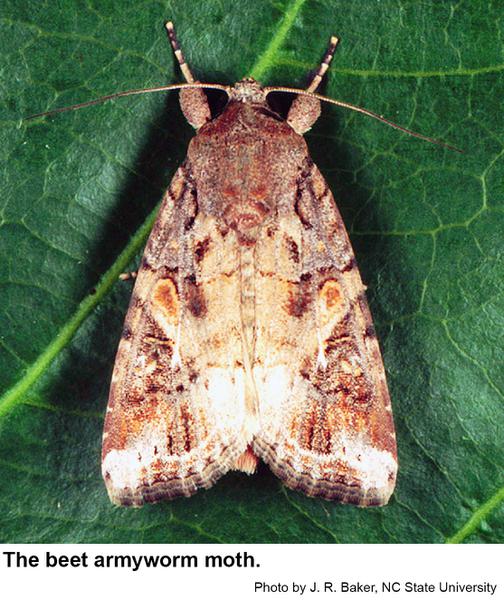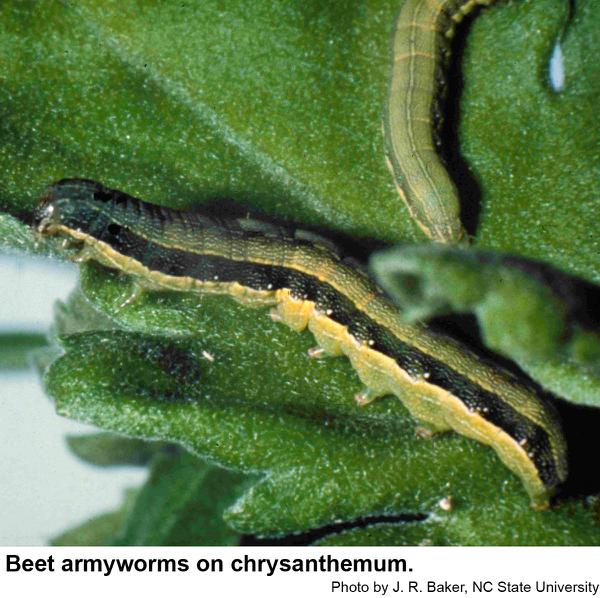Description and Biology
The adult beet armyworm, Spodoptera exigua, is a grayish brown moth with a pale circular spot near the middle of the forewing. The wingspan is an inch or slightly more. The hind wings are whitish with dark edges. First and second stage caterpillars are pale green with dark heads. Older caterpillars are green to almost black with stripes along each side. Beet armyworms always have a black spot on the side above the second pair of legs (counting from the head). The pupa is smooth and light brown at first, but it soon darkens. A new generation of moths molts from pupae. Each moth can lay up to 600 eggs during their week-long life although some may live up to 30 days. Females begin laying two days after mating, and they prefer young rather than old plants. Flight activity is greatest in July and August. Eggs are laid in masses of 15 to 150 mostly on the undersides of leaves and mostly within four inches above the soil. Females may cover the eggs with a mat of scales that helps protect them from parasites and insecticides. Two to 9 days later the eggs hatch. When the tiny worms hatch, they feed in groups especially in the growing tips where they usually web several leaves together. The third and fourth stages last one to three days. The fifth stage feeds for two to six days. Beet armyworms are cannibalistic especially when feeding on plants starved for nitrogen. Moths that develop from cannibalistic caterpillars lay more eggs than moths that developed from caterpillars that feed only on plant material! Mature beet armyworms tunnel into the soil about an inch or three and form a cell in which they pupate. The pupal stage lasts about a week although overwintering pupae develop much longer. The moths are nocturnal and mating and egg laying occur at night. The beet armyworm has several generations per year.
Host Plants
The beet armyworm has an extremely wide host range including mums, marigolds, carnations, and roses as well as vegetables, cotton and soybeans. Young beet armyworms web foliage together and feed within this shelter. They also bore into flower buds. Older larvae feed extensively on flowers, buds, fruit, and foliage. Weeds infested include feverfew, lambsquarters, mullein, pigweed, purslane, portulaca, and Russian thistle.
Residential Recommendations
In other parts of the country, beet armyworms are resistant to pesticides. I do not think this is the case in North Carolina, perhaps because our mesic climate supports abundant weeds on which the beet armyworm can develop readily. Thus, here only a small portion of the population is treated with insecticides so that any acquired resistance is swamped out by moths that were never sprayed as caterpillars. Young larvae are very susceptible to pesticides but they usually reside inside the webbed foliage where it may be difficult to spray them. Older larvae feed on the open leaves and are more accessible, but they are more tolerant of pesticides. Most of the pyrethroid insecticides labeled for residential landscapes should give adequate control. When used as directed, pyrethroids are very toxic to insects but are not particularly hazardous to humans and pets (other than fish-avoid using pyrethroids around pools, ponds, and streams).
References
- Common name: beet armyworm, scientific name: Spodoptera exigua (Hübner) (Insecta: Lepidoptera: Noctuidae). Capinera, J. R. 2014 (revised). Featured Creatures, Entomology & Nematology, FDACS/DPI, EDIS. Publication Number: EENY-105.
- Insect and related Pests of Flowers and Foliage Plants. Baker, J. R., ed. 1994. NC Coop. Extension Service Pub. AG-136. 106 pp.
- Insect and related Pests of Vegetables. Sorensen, K. A. and J. R. Baker, editors. 1994. NC Coop. Extension Service Pub. AG-295. 180 pp.
- Extension Plant Pathology Publications and Factsheets
- Horticultural Science Publications
- North Carolina Agricultural Chemicals Manual
For assistance with a specific problem, contact your local Cooperative Extension Center
This Factsheet has not been peer reviewed.
Publication date: Sept. 26, 2016
Reviewed/Revised: June 30, 2021
Recommendations for the use of agricultural chemicals are included in this publication as a convenience to the reader. The use of brand names and any mention or listing of commercial products or services in this publication does not imply endorsement by NC State University or N.C. A&T State University nor discrimination against similar products or services not mentioned. Individuals who use agricultural chemicals are responsible for ensuring that the intended use complies with current regulations and conforms to the product label. Be sure to obtain current information about usage regulations and examine a current product label before applying any chemical. For assistance, contact your local N.C. Cooperative Extension county center.
N.C. Cooperative Extension prohibits discrimination and harassment regardless of age, color, disability, family and marital status, gender identity, national origin, political beliefs, race, religion, sex (including pregnancy), sexual orientation and veteran status.



